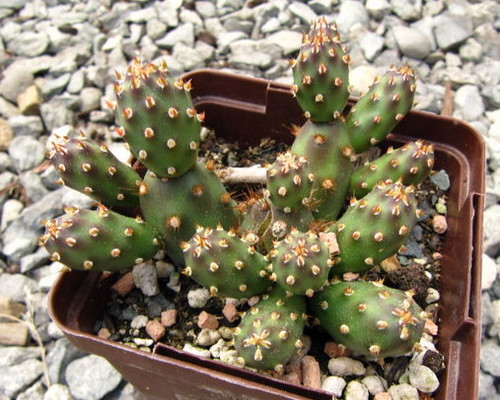Pot Size: 1 gal Pot
Accepted Scientific Name:
Opuntia ficus-indica 'Burbank Spineless'
Origin and Habitat
Opuntia ficus-indica originates from Mexico and has been widely cultivated throughout arid and semi-arid regions of the world, including the Mediterranean, South Africa, and parts of the United States. The 'Burbank Spineless' variety was developed by renowned horticulturist Luther Burbank in the late 19th century in California. Burbank aimed to create a more user-friendly prickly pear with minimal spines, ideal for both agricultural use and ornamental cultivation. In its natural and cultivated habitats, it thrives in open, sunny areas with well-draining soils and is highly drought-tolerant.
Description
Opuntia ficus-indica 'Burbank Spineless' is a robust, upright-growing cactus that can reach up to 72 inches (6 feet) tall or more in the ground. It features broad, flattened, paddle-shaped cladodes (pads) with smooth surfaces and nearly no spines, making it easier to handle. The pads are a vibrant blue-green and store water efficiently. In spring to early summer, it produces large, showy flowers that range in color from yellow to orange. These are followed by edible, pear-shaped fruits known as “tunas,” which ripen to red or purple and are valued for their sweet, juicy flavor.
Cultivation
Zone USDA Zones 9–11
Temperature Prefers warm temperatures between 20°C and 35°C. Protect from hard frost below 0°C.
Growth Rate Fast-growing under warm, sunny conditions.
Soil Thrives in well-draining soil with pumice added to promote aeration and prevent rot.
Watering Water deeply but infrequently. Allow soil to fully dry between waterings. Reduce significantly in winter.
Fertilizing Use a balanced liquid fertilizer every 2–3 weeks during the growing season (spring to summer).
Light Needs full sun to thrive. Ensure at least 6 hours of direct sunlight daily.
Pests and Diseases Generally pest-resistant but can occasionally suffer from cochineal scale, mealybugs, or root rot. Treat pests with insecticidal soap and maintain good airflow and drainage to prevent disease.
Propagation
Easily propagated through pad cuttings. Let cut end callous for a few days before planting in pumice-rich soil. Water sparingly until roots establish.
Notes: This is for a full pot of multiple rooted pads.







